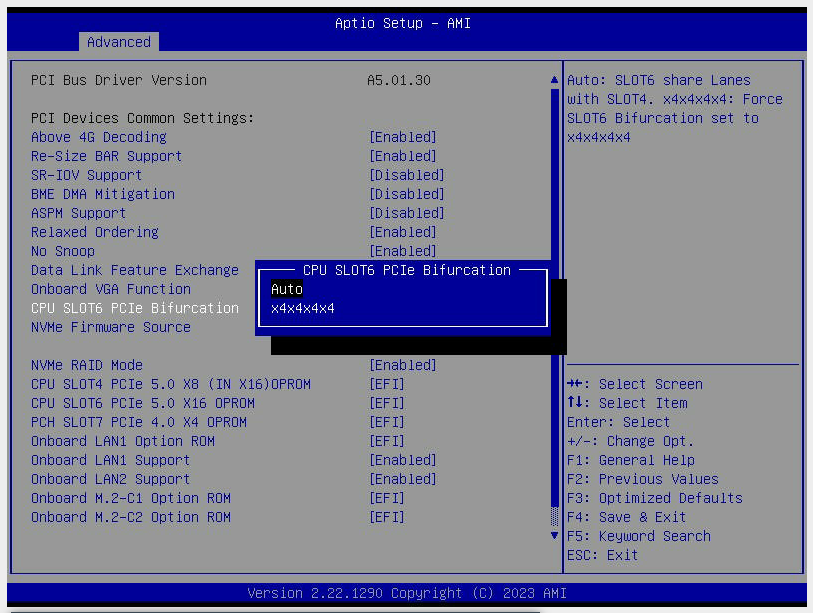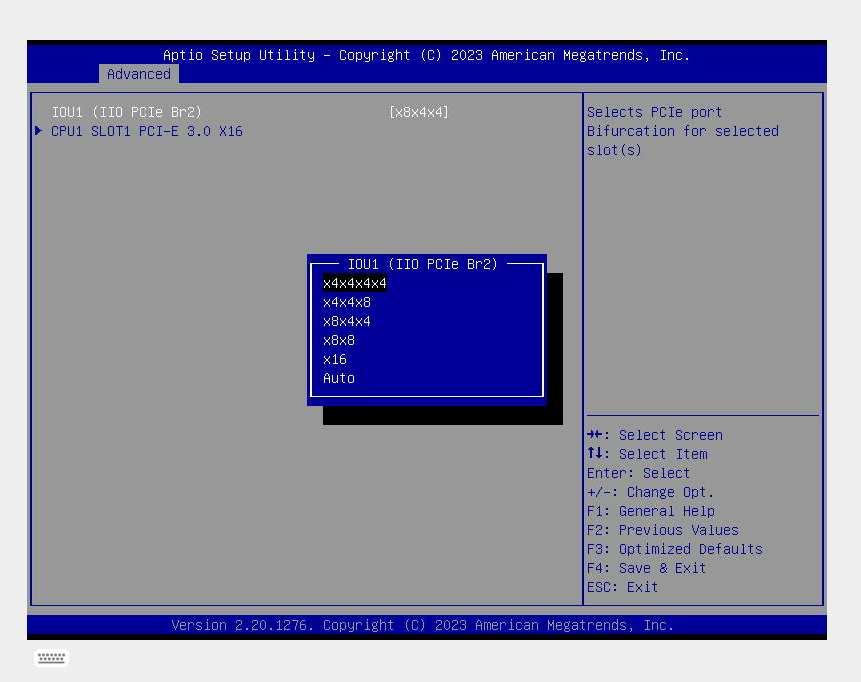Supermicro AOC-SLG3-2M2 Controller Only recognizes One NVMe Drive, Why? (PCIe Bifurcation)
| F.A.Q. • SupportSupermicro AOC-SLG3-2M2 Controller Only Detects One NVMe Drive, Why?
The issue of only one M.2 NVMe drive being recognized by the BIOS on the AOC-SLG3-2M2 adapter connected to the motherboard can arise from several factors. Here are possible causes and troubleshooting steps:
BIOS/UEFI Configuration:
- Check if the BIOS/UEFI is up to date. Supermicro often releases updates to improve hardware compatibility.
- Look for settings in the BIOS related to NVMe, PCIe bifurcation, or the specific AOC-SLG3-2M2 adapter. Ensure that the settings support multiple NVMe drives:
-
BIOS-->Advanced-->PCIe/PCI/PnP Configuration-->PCIe slot# Configuration
- Please kindly change the PCIe slot# Bifurcation setting to "x4x4x4x4"
For motherboard with single CPU and one PCIe slot: 
- For motherboard with dual CPUs and few PCIe slots.

-
PCIe Slot Configuration:
- Ensure that the AOC-SLG3-2M2 adapter is installed in a PCIe slot that supports the required lanes for both NVMe drives. Some slots may only support one drive if they do not have enough PCIe lanes.
- Check if PCIe bifurcation (splitting a single PCIe slot into multiple x4 lanes) is required and properly configured in the BIOS.
Adapter and Drive Compatibility:
- Confirm that the AOC-SLG3-2M2 adapter supports the specific NVMe drives you are using. Supermicro adapters have compatibility lists.
- Make sure both NVMe drives are properly mounted and functioning. Test each drive individually in the same slot to rule out defective drives.
Firmware Updates:
- Check if there are firmware updates for the AOC-SLG3-2M2 adapter that might address compatibility or recognition issues.
Physical Installation:
- Ensure that the adapter is properly installed in the PCIe slot. Sometimes reseating the adapter can resolve connectivity issues.
- Ensure that the NVMe drives are properly installed in the adapter's slots and that any required power connections are secure.
Testing and Diagnostics:
- Use diagnostic tools to check if both NVMe drives are recognized by the system once it boots into the operating system. Sometimes, the BIOS might not show all connected drives, but the OS can still detect them.
Windows
-
Device Manager:
- Press
Windows + Xand select "Device Manager". - Expand the "Disk drives" section and check if both NVMe drives are visible.
- Press
-
Disk Management:
- Press
Windows + Xand select "Disk Management". - In the "Disk Management" window, check if both drives are visible. If they are new, they might be unallocated and require initialization.
- Press
-
CrystalDiskInfo:
- Download and install CrystalDiskInfo.
- Run the program to see detailed information about all connected NVMe drives.
-
Samsung Magician (for Samsung NVMe drives):
- Download and install Samsung Magician.
- Run the program to manage and monitor Samsung NVMe drives.
Linux
-
lsblk:
- Open a terminal and type
lsblk. - This command will display a list of all block storage devices. NVMe drives will be listed as
nvme0n1,nvme1n1, etc.
- Open a terminal and type
-
lspci:
- Open a terminal and type
lspci | grep -i nvme. - This command will show if the NVMe controllers are detected by the system.
- Open a terminal and type
-
nvme-cli:
- Install the
nvme-clitool (available in most distribution package repositories). - Type
sudo nvme listto see a list of all NVMe drives and their details.
- Install the
-
Gnome Disks (gnome-disk-utility):
- Install the
gnome-disk-utilitytool (if not already installed). - Run "Disks" from the applications menu to see information about all connected drives.
- Install the
MacOS
-
Disk Utility:
- Open "Disk Utility" from the "Utilities" folder.
- Check if both NVMe drives are visible in the list of devices.
-
System Information:
- Click the Apple logo in the upper left corner and select "About This Mac", then "System Report".
- Go to the "NVMExpress" section to see details about the connected NVMe drives.
Using the above tools, you can check if both NVMe drives are recognized by the operating system and obtain detailed information about their status and configuration.
Motherboard Support:
- Review the motherboard manual or contact the manufacturer to ensure that the M12SWA-TF fully supports the AOC-SLG3-2M2 adapter with multiple NVMe drives.
Systematically checking each of these areas will help identify and resolve the issue of only one M.2 NVMe drive being recognized by the BIOS in your system.
Related pages:
- Supermicro SYS-6029TR-DTR How to disable / enable ASPM?
- How to Enable VT-d (IOMMU) on Supermicro Motherboards Using the Example of X11SCZ-F?
- Installing Windows on an M.2 NVMe drive [AMI Native Support].
- The NVMe drive is marked as faulty by the BIOS on Supermicro motherboards (NVM Express Controller Failed)
- Updating NVMe Drive Firmware Using nvme-cli: Example with Samsung PM9A3
- How to Format an NVMe Drive? How to Permanently Erase Data from an NVMe Drive?


